Skin has been classified differently over the years. The main purpose of the classification is to help dermatologists and other skin specialists to determine the response of their clients’ skin to different treatments and injuries .
Therefore, skin typing was not initially from a consumer’s point of view. In the recent years however, companies have taken advantage of skin typing to market the same products in different packages in the name of catering to specific skin types.
There are several scales that were developed to classify the skin. I came across 10 that each serve a different purpose. I zero in on two of them which I find most complete.
Table of Contents
The Helena Rubenstein Classification (early 1900s)
The most popular classification system was developed by an entrepreneur named Helena Rubenstein. In the 1900s, she claimed that dry, oily, combination, or sensitive were the best words to label what could be considered the four fundamental types of skin.
Some people believe that this is the best way to classify the skin because it separates the skin’s characteristics from skin conditions . It’s kind of hard to do this especially if you may not have a skin condition but are predisposed to it .
Most skin classifications combine the two . Also, our skin is not static . It changes a lot depending on products we use, the environment , our lifestyles and age .
The FitzPatrick(FZ) Scale (1975)
This scale classifies skin based on its phototype: the ability to burn and tan when exposed to UV radiation(UVR). It focused on the colour of the skin and eyes and the ability of that skin to burn and tan.
Naturally, darker skin tones (types V and VI) , are considered less sensitive to UVR. Unfortunately, this has misled people with darker skin to believe that they do not need UVR protection. Nonetheless, it is still an important system used to this day particularly by dermatologists.
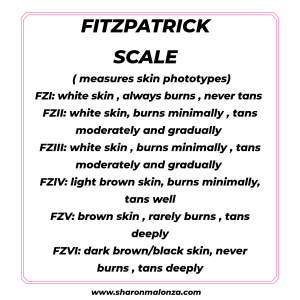
There is another system that is also based on UVR but is limited to Japanese individuals. It is known as the Kawada skin classification system (1986)
The Glogau Scale (1994)
This scale is about the degree of photoaging. It categorizes the amount of wrinkling and discolouration in patients’ skin but doesn’t really cater to mixed ethnic-racial skin types.
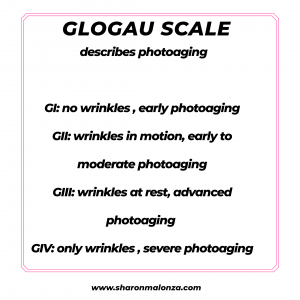
Lancer ethnicity scale (1998), Goldman world classification of skin type (2002) and Fanous classification (2002)
There are a number of scales that look at how different skin colours respond to burning, tanning, post-inflammatory pigmentation. This information is used to determine how patients would respond to skin treatments such as laser treatments, chemical peels and dermabrasion.
Willis and Earles Scale (2005), Taylor hyperpigmentation scale (2006) and Roberts hyperpigmentation scale
These scales cater more to darker skin tones as they evaluate and grade pigmentation disorders.
General rules of thumb:
- The lighter you are the higher the risk of sunburn.
- The darker you are, the higher the risk of hyperpigmentation.
The Roberts scarring scale
It measures patients’ pattern of scarring which helps to determine the effects of many medical treatments and procedures.
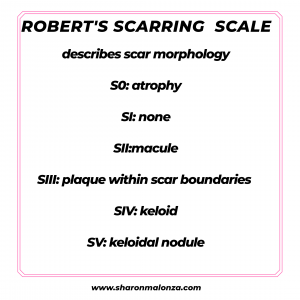
The Roberts Skin Type Classification System
Roberts was smart.He basically put many scales together and came up with an ultimate skin typing system.
This has 4 elements, all of which I’ve mentioned above:
- FitzPatrick scale (FZ)
- Robert’s hyperpigmentation scale (H)
- Glogau scale (G)
- Robert’s scarring scale (S)
The Baumann skin type solution (2006)
This , to me, is one of the most thorough classifications for consumers. It was popularized by a cosmetic dermatologist named Leslie Baumann in her book ‘The Skin Type Solution’ .
She believes that the four barriers to skin health are inflammation, pigmentation, dehydration and aging. Therefore , she has derived four parameters to characterize facial skin types: dry or oily; sensitive or resistant; pigmented or nonpigmented; and wrinkled or unwrinkled (tight). Evaluating skin based on all four parameters yields 16 potential skin-types.
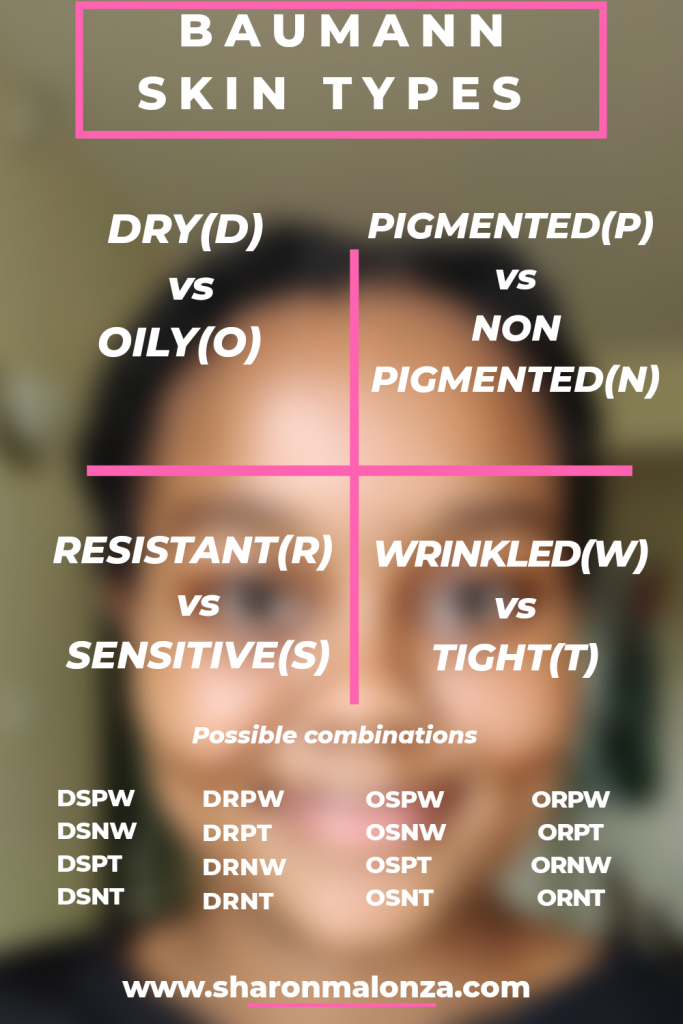
Dry or oily
This is typically a spectrum with dry and oily at the extreme ends of one another.
Dry
Dry skin is also known as xerosis. It tends to be dull, have rough texture and an elevated number of ridges. Sometimes it flakes excessively and feels tight.
It is often due to an impairment or imbalance in the skin barrier that leads to increased trans-epidermal water loss (TEWL).
Dry skin can also be due to low sebum production .
Unfortunately, these qualities makes dry skin more prone to damage than oily skin. It also ages much quicker if not well taken care of .
IS MY SKIN DRY OR DEHYDRATED ?
It depends on what your skin is lacking . Dry skin mainly lacks the fatty acid component of the skin barrier . On the other hand , dehydrated skin is lacking some of the parts of the natural moisturizing factor which attract and retain water ( humectants)
So it is possible for your skin to be oily AND dehydrated or dry AND dehydrated.
I’ll discuss moisturizing in more detail in a separate post .
Generally , dry skin needs adequate moisture and hydration .
Oily
Oily skin is commonly a result of elevated sebum production. Sebum is the oily secretion made by sebaceous glands that contain wax esters, sterol esters, cholesterol, di- and triglycerides and squalene.
Sebum levels are typically low during childhood, increase in middle and late teens and remain relatively stable until they decrease in our 70s due to a decline in certain hormones.
Many factors affect its production like genetics, diet , stress levels and hormones.
“Normal” skin is what falls in the middle of these two extremes. It has an intact skin barrier with normal levels of natural moisturizing factor and hyaluronic acid balanced sebum secretion. Elevated sebum secretion is what would make this skin type tip over to the oily side of the spectrum.
Barrier to healthy skin: excess sebum
Treatment:reduce sebum production.
Sensitive vs Resistant
Resistant
Resistant skin is characterized by a strong stratum corneum. Redness and acne are rare in people with resistant skin unless due to stress, hormones and sun overexposure.
If you have resistant skin, you can use most skin care products without any fear. The downside of this is that many products are ineffective because this skin type has such a high threshold for ingredient efficacy and penetration. Many product formulations will be too “weak” to give any benefits.
Sensitive
This skin type is fairly complex. Baumann further divides into 4 subtypes:
- Acne type
Prone to develop acne , blackheads or whiteheads.
Acne is a huge topic because there are numerous types and manifestations of it. In general , it originates from a combination of increased sebum production, clogged pores, a bacterial infection and inflammation.
Treatments of acne target each of these four steps in its formation.
- Rosacea type
Prone to redness, flushing of the skin, papules (tiny bumps under the skin) and experiencing hot sensations. This is another complex skin condition that’s not fully understood.
- Stinging type
Prone to stinging or burning sensations.
The stinging response is a nonallergic sensitivity. Many people feel stinging without redness. However, people with rosacea often have it as well.
I think this skin type is more common than people think and many skin ingredients that are promoted would rather be avoided in this skin type. These include alpha hydroxy acids, formaldehyde, propylene glycol, sodium lauryl sulfate, formaldehyde, urea and vitamin C.
- Allergic type
Prone to erythema (superficial redness of the skin due to dilation of blood capillaries), itching and skin flaking.
This skin type is common in women aged 20-60. The most common allergens are fragrances and preservatives. Those with an impaired skin barrier are also more prone to this.
Despite differences, the four sub-types of sensitive skin share one important feature: inflammation. Thus, one of the most important courses of treatment is to decrease and eliminate inflammation.
Pigmented vs non-pigmented
This classification is based on the predisposition to hyperpigmentation on the face, chest and arms.
Melanin is a skin pigment produced by melanocytes in the skin that gives it its colour. It is well known that darker-skinned people produce more melanin than lighter people.
UVR can also induce melanin production . However, in this case,it is the skin’s way of defending itself to the UV exposure. This is why, not wearing sunscreen can worsen pre-existing hyperpigmentation and increase the risk of it.
Treatment:
- The main course of treatment is to inhibit the main pathways of melanin formation. .
- Exfoliating agents can increase cell turnover faster than melanin is produced which can also help.
- Use of broad spectrum sunscreen is imperative for everyone, especially if you are prone to hyperpigmentation.
Wrinkled vs tight
Skin aging can be divided into intrinsic and extrinsic aging. Natural intrinsic aging is inevitable while extrinsic aging is preventable. Extrinsic aging can be caused by smoking, poor nutrition, excessive alcohol consumption and especially sun exposure.
Treatment:
- Practice good lifestyle habits that do not promote accelerated aging.
- Use of topical and oral products that boost the levels of collagen, elastin and hyaluronic acid (which all decline with age).
When it comes to aging in particular, prevention is easier and more effective . Most anti-aging products won’t reverse the aging process but maybe slow down its progression.
What is your skin type?
I know this is an overwhelming amount of information. I will revisit many of these concepts in greater detail so I wanted to have mentioned them beforehand.
Here is a quick summary :
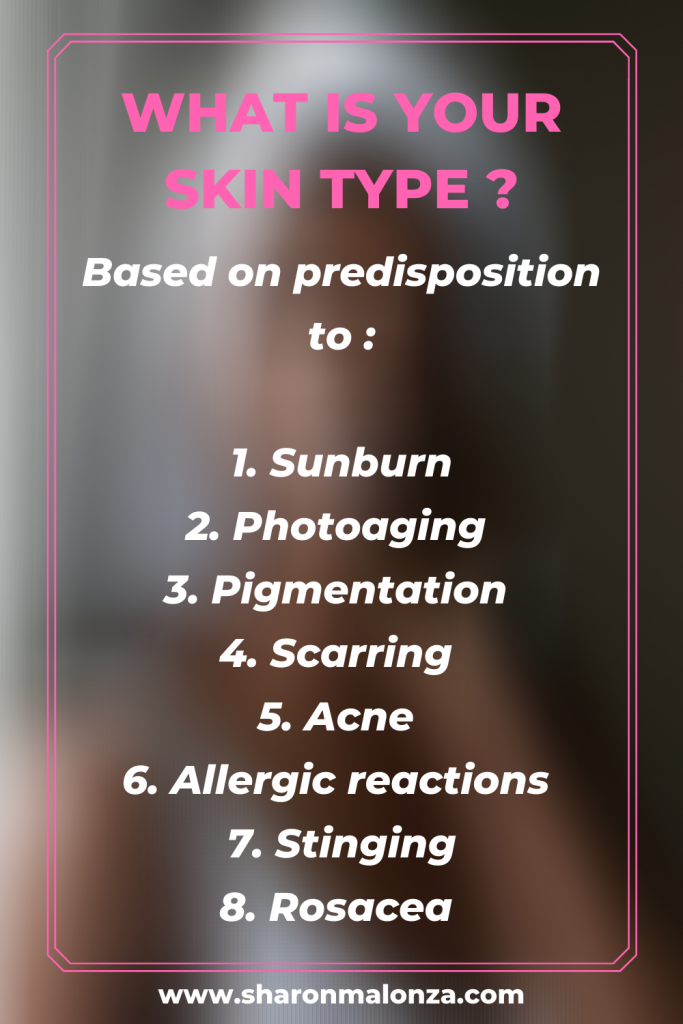
Notice I did not bring up the word “combination” skin. Technically, everyone has a combination of different skin types so it’s a vague term that does not help much.
Based on ALL that information, I’ll go first:
- Dehydrated
- Sensitive: allergic sub-type
- Pigmented
- Prone to scarring
- Tight
My Baumann skin type is DSPT. What is yours?
Take your time with the post and leave any questions or comments you have down below.
Thank you so much for stopping by!
“Always remember that your hair is your crown and your body is a temple; embrace it, love it and take care of it. “
God bless you all.
References
- Dermatol Clin 27 (2009) 529–533 doi:10.1016/j.det.2009.08.006 0733-8635/09/$
- Baumann, L. (2008). Understanding and Treating Various Skin Types: The Baumann Skin Type Indicator. Dermatologic Clinics, 26(3), 359–373. doi:10.1016/j.det.2008.03.007
- https://lesliebaumannmd.com/baumann-skin-type-quiz/

This is one of the most detailed write up on skin type I have seen in a long time. Very helpful.
My skin type is
Oily
Sensitive: Acne Subtype
Pigmented
Tight
I tried to be as thorough as I could . Thank you for your feedback 😊 will be sharing more tips on how to cater to your skin type in future posts